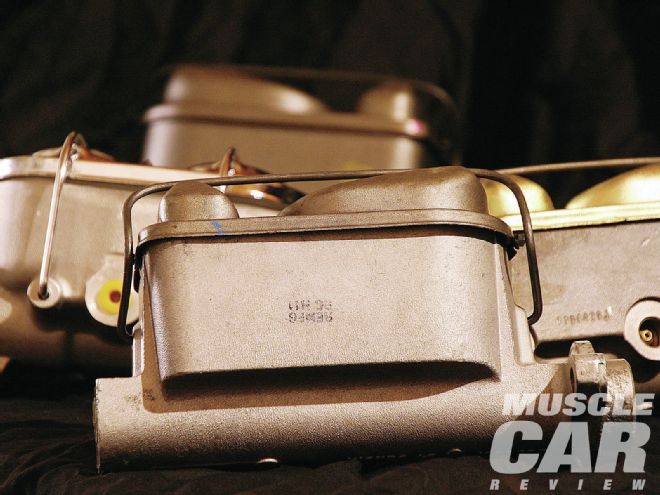
Muscle cars don’t drive like modern vehicles. No lie, huh? But we’d guess there’s a reason for this that most car hobbyists don’t always consider: weight. Or, more accurately, where the weight is located in today’s cars versus yesterday’s.
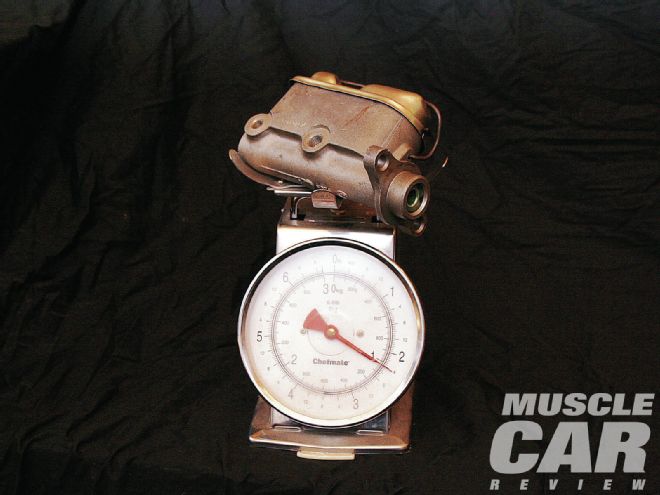 Looking just like stock cast-steel master cylinders, the ones cast from aluminum tip the scales at between 2½ and 3 pounds, while the cast-steel units we weighed came in at 8 pounds or more.
Looking just like stock cast-steel master cylinders, the ones cast from aluminum tip the scales at between 2½ and 3 pounds, while the cast-steel units we weighed came in at 8 pounds or more.
While the advertised curb weight for a lot of today’s fullsize vehicles is similar to our vintage cars, the weight distribution is much different. With safety equipment, airbags, sound deadener, electronics, and a host of other amenities, today’s passenger compartments carry a lot more weight than they used to. To make up for that added load, lighter components have found their way onto other areas of the cars, including under the hood. You’ll now find aluminum used not just for heads but also for water pumps, radiators, brackets, and even engine blocks. Plastic is used extensively to make fans, air cleaner housings, radiator tanks, and more. Over the years, cast iron two-barrel intakes were replaced with aluminum, and now they’re plastic. Combine this significant weight loss over the nose with the engine setback found in most of today’s vehicles, and even pickups handle better than our muscle cars originally did.
Anybody who has spent time on the dragstrip, or with their nose buried in a car magazine over the last 15 years, has heard, “every 100 pounds is worth a tenth in the quarter-mile.” Likewise, anyone who saws the steering wheel around a road or cone course knows that taking weight off the nose of the car is one of the best ways to improve cornering.
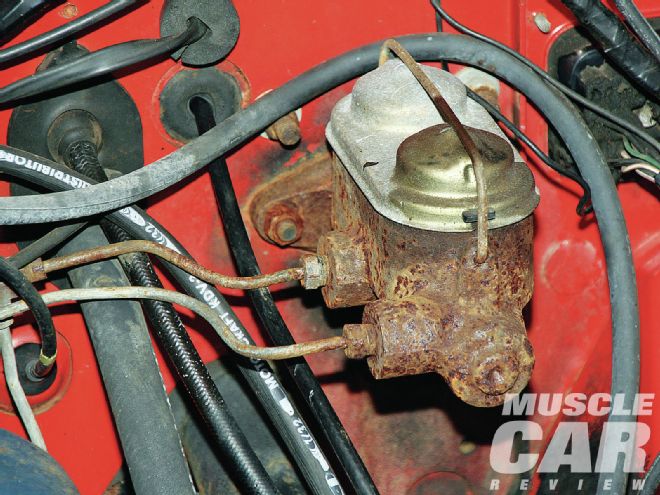 Most passenger cars have the ports on the driver side, but ’60s and early ’70s AMCs have the ports on the passenger side, as on this Javelin.
Most passenger cars have the ports on the driver side, but ’60s and early ’70s AMCs have the ports on the passenger side, as on this Javelin.
Aluminum parts are obvious options for taking weight off a car without compromising its drivability. If done properly, those aluminum components can be hidden in plain sight, even on restored muscle cars. A little work with a grinder and some paint will camouflage aluminum heads, intake manifolds, and water pumps, while stamped-tank aluminum radiators (fogged in black) shave more pounds over the OE copper-core versions.
All told, these changes might take off 75 to 100 pounds or more, depending on how much effort you’re willing to go through. For instance, you could replace a few simple brackets with aluminum pieces and bolt on a high-torque mini-starter. Five pounds here, a pound and a half there, and things can add up. Racers know this, and the guys in the Factory Appearing/Stock Tire cars have taken it to an art form that’s closer to a science.
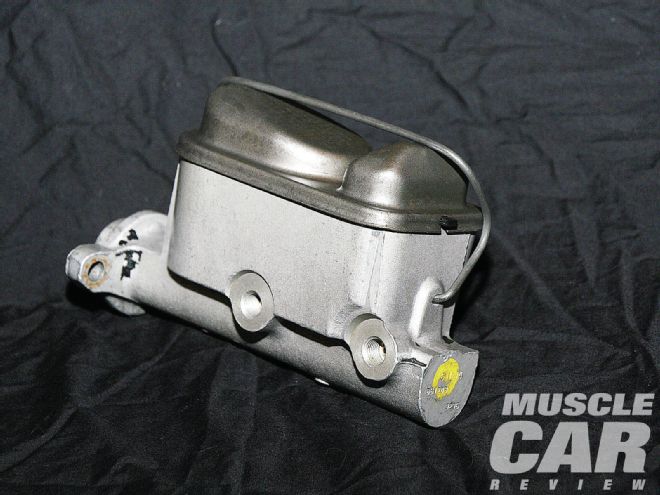 Some Fords and Jeeps from the late ’80s had aluminum master cylinders with ports on the passenger side. The ’85 Lincoln Town Cars and ’89 Jeep Cherokees have the ports on the passenger side, so there’s your starting point. You’ll need to do some research on bore diameter and disc/drum applications with the internal residual pressure valve.
Some Fords and Jeeps from the late ’80s had aluminum master cylinders with ports on the passenger side. The ’85 Lincoln Town Cars and ’89 Jeep Cherokees have the ports on the passenger side, so there’s your starting point. You’ll need to do some research on bore diameter and disc/drum applications with the internal residual pressure valve.
Is jettisoning weight from the nose of your muscle car really going to make a big difference? Honestly, it’s not going to make a ’70 Challenger handle like a ’12 Challenger—and maybe not even like a Dodge Dakota, for that matter! It won’t add 10 mpg to your fuel economy either. But in a world where every little bit helps, we still dig the concept. There’s no way a restored or restomod muscle car is going to perform like a new car, but there’s no reason not to maximize its potential.
One of the more uncommon places you can save weight is with the master cylinder. We’ve all seen early cars with late-model lightweight master cylinders. Almost always they are the modern two-piece design with an aluminum lower cylinder housing and a plastic reservoir on top. Frankly, they’re ugly. For that reason they’re rarely found on restored or lightly modified muscle cars, though they’re nearly mandatory on Pro Touring or other high-performance muscle and race cars.
But we found that in the ’80s, before the two-piece plastic-reservoir master cylinders become so common, several vehicles had the old block-style master cylinder cast in aluminum rather than steel. The weight difference is substantial, while the difference in looks is negligible.
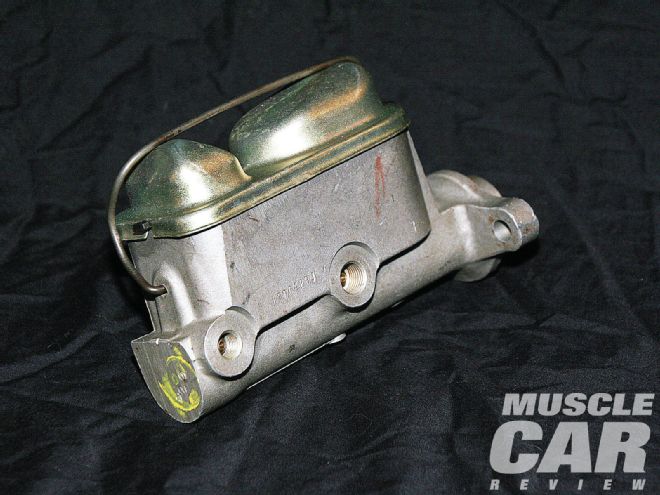 Master cylinders from other Fords, such as this aluminum Ranger unit, had the ports on the driver’s side, making it a lot easier to fit to Ford and Mercury muscle cars.
Master cylinders from other Fords, such as this aluminum Ranger unit, had the ports on the driver’s side, making it a lot easier to fit to Ford and Mercury muscle cars.
The Ford camps are the most easily covered, with aluminum two-chamber master cylinders found on early ’80s Lincolns, Ranger pickups, and Mustangs. Remarkably, the AMC crowd also has options, as AMCs frequently have the outlet ports on the passenger side. Later Jeeps and a couple of Ford applications have them exiting on that side as well.
For GM fans, the fix isn’t quite as seamless. Speedway Motors recently released a GM-style aluminum master cylinder patterned from a Corvette unit. The one giveaway for our purposes is that it has outlet ports on both sides: driver (as per original) and passenger side. The unused ports are capped off, but you’ll see them.
Mopar guys, unfortunately, seem to be out of luck. We aren’t certain, but from what we’ve been able to gather, Mopars went right from the cast steel masters to the lightweight aluminum/plastic two-piece master cylinders without the cast aluminum version in between. With some savvy power-booster shopping, a simple adapter, or some work with a TIG welder and some light machine tools, a Ford master could be adapted fairly easily.
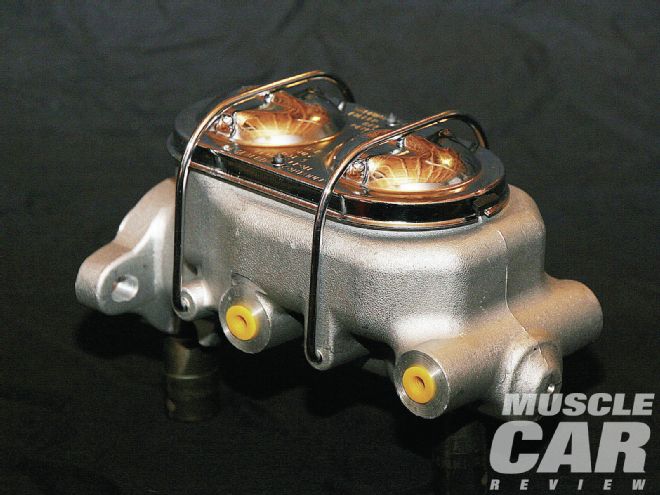 Speedway Motors recently released an aluminum master cylinder based on the Corvette design. It has ports on both sides. Aesthetically, it may or may not be what you’re looking for, but since it’s about 5 pounds lighter than an iron piece, it’s a nice compromise between heavy iron and an ugly two-piece aluminum unit with the plastic reservoir.
Speedway Motors recently released an aluminum master cylinder based on the Corvette design. It has ports on both sides. Aesthetically, it may or may not be what you’re looking for, but since it’s about 5 pounds lighter than an iron piece, it’s a nice compromise between heavy iron and an ugly two-piece aluminum unit with the plastic reservoir.
Unfortunately, it’s a computer age, and anyone who has tried to buy a dash bulb from the local parts store knows how little leeway there is when trying to find anything that’s not specific to your application. It’s not like the old days when you could sit on a stool at the parts counter and leaf through the store’s catalog and match bore diameters and residual valves until you found another application that would work. We weren’t even able to find full online charts showing the part numbers, bore diameter, outlet side, and casting material, but this information should be available in old parts store catalogs.
We did discover that certain applications use a similar housing but will have different specs. For instance, the ’85 Ford Ranger and the ’84-’85 SVO Mustang use master cylinders that have part numbers only a couple of digits off in the parts catalog, but the Mustang has a bigger bore. So once you find a part number with an aluminum body, start looking at the part numbers around it and see what their applications are.
We started by looking through a store catalog and online catalogs to see pictures of master cylinders. We picked ones that looked like they were cast in aluminum, then had our parts guy verify the numbers they had in stock to see if they were aluminum or steel.
From that starting point, we can go forward and determine piston bore sizes, residual valves, and whether we can use them for disc/drum, disc/disc or drum/drum setups on a muscle car. That information will be available in old parts catalogs, online, at swap meets, or on enthusiast websites.
They say the hunt is half the fun, right? This bit of information should be enough to set you on the path.